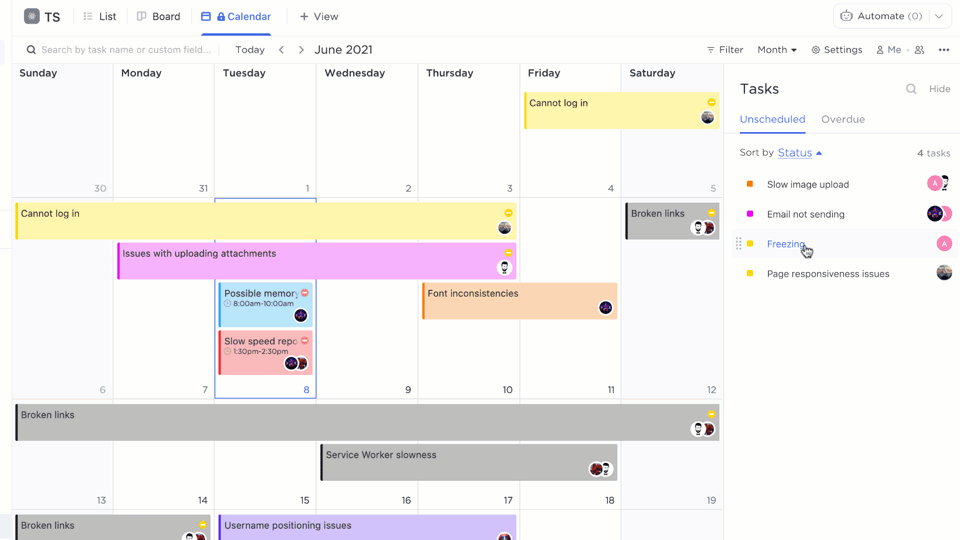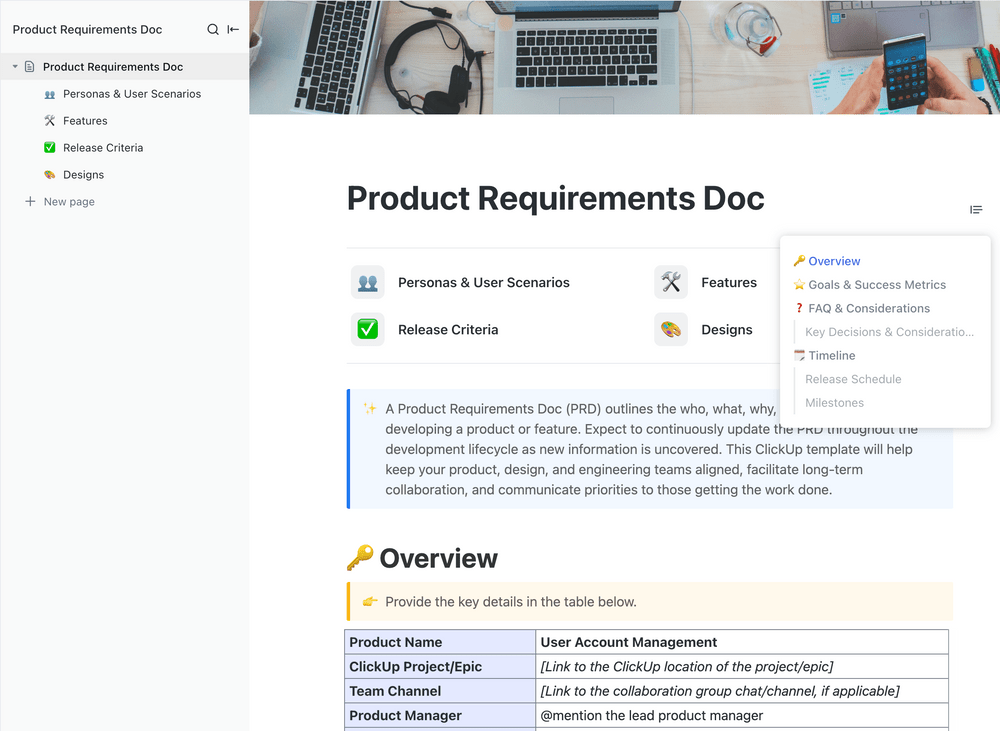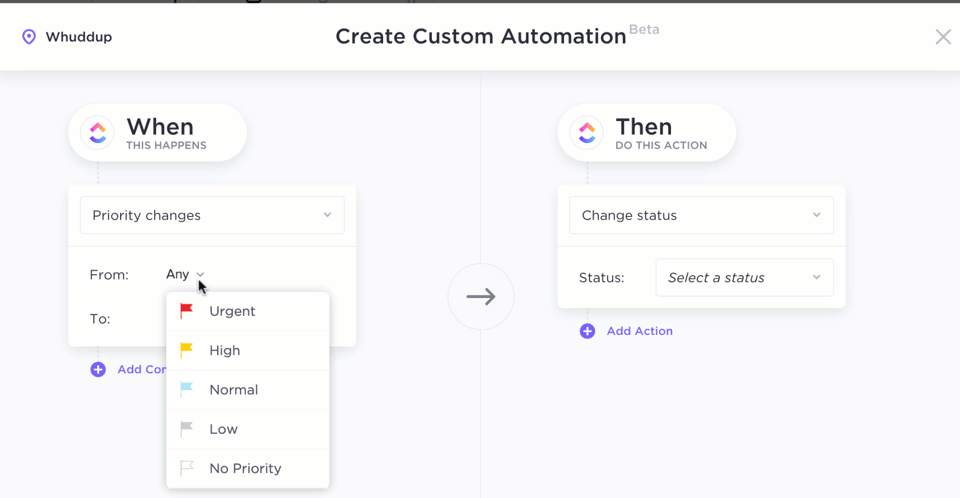قبل البدء في أي مشروع، من أول الأمور التي يحددها المديرون هو الموعد النهائي، أي اليوم الذي يجب تسليم المشروع قبله. يعمل الموعد النهائي، المعروف أيضًا باسم تاريخ الاستحقاق، كموعد نهائي للمشروع.
في دراسة لمديري المنتجات جارتنر أن 45% من عمليات الإطلاق تتأخر لمدة شهر على الأقل! عبر المشاريع والإدارات والمؤسسات والمناطق الجغرافية، فإن التأخر عن المواعيد النهائية أمر شائع إلى حد ما لأسباب مختلفة.
في منشور المدونة هذا، نستكشف سبب أهمية الالتزام بالمواعيد النهائية، والتحديات التي تواجهها، وكيفية تحسين فرصك في الوفاء بالمواعيد النهائية في مشاريعك.
أهمية الوفاء بالمواعيد النهائية
أثناء التوقيع على الخط المنقط، تلتزم فرق المشروع بموعد نهائي. وهذا الالتزام بحد ذاته سبب كافٍ للوفاء بها. ولكن هناك المزيد.
المصداقية: إن الوفاء بالمواعيد النهائية الملتزم بها هو العلامة الأساسية للمصداقية. فهو يدل على أنك موثوق وجدير بالثقة.
التميز التشغيلي: يُظهر تسليم المشروع في الوقت المحدد مهاراتك وقدراتك وتميزك التشغيلي. فهو يُظهر قدرتك على تقدير المشروع وجدولته وتسليمه.
الحصافة المالية: في بعض الأحيان، تحتوي العقود على شروط جزائية للتأخر في التسليم، مما يعني أنك قد تخسر المال لعدم الوفاء بالمواعيد النهائية للمشروع. يضمن إنجاز المشروع في الوقت المحدد حصولك على ما اتفقت عليه.
حرية التخطيط المسبق: عندما تعرف أنه سيتم إنجاز المشروع في الوقت المحدد، يمكنك جدولة المشروع التالي بثقة. وهذا يساعد على استمرارية العمل، وبالتالي الربحية.
على الرغم من أنه من البديهي أن الوفاء بالمواعيد النهائية هو أبسط الأمور المهنية، إلا أنه ليس من السهل دائمًا.
التحديات الشائعة للوفاء بالمواعيد النهائية
غالباً ما تواجه المؤسسات تحديات في الوفاء بالمواعيد النهائية التي التزمت بها. ومن أكثرها شيوعاً ما يلي.
الإفراط في الالتزام: قد يكون فريق المبيعات قد بالغ في الالتزام بالموعد النهائي، وهو ما تواجه فرق المشروع صعوبة في الوفاء به.
الاستخفاف بالتقدير: غالبًا ما تستهين فرق المشروع بالجهد المبذول، فتلتزم بموعد نهائي ضيق للغاية.
جدولة غير قابلة للتحقيق: تحتاج فرق المشروع إلى وقت لفهم المتطلبات وتكثيف الجهود. من خلال جدولة المهام منذ اليوم الأول، يضع مديرو المشاريع أنفسهم وفرقهم في مواجهة موعد نهائي غير منجز.
سوء تحديد الأولويات: للمهام تسلسل هرمي وتبعيات. من خلال عدم ترتيب الأولويات بشكل صحيح، ستقع الفرق في حالة من الفوضى والارتباك، مما يؤدي في النهاية إلى فقدان المواعيد النهائية.
عدم التعاون: عندما لا يتواصل أعضاء الفريق المختلفون مع بعضهم البعض بشكل منتظم، فمن المحتمل أن تسقط المعلومات من خلال الشقوق. وينتج عن ذلك تسليم دون المستوى المطلوب، وهو ما يؤدي إلى إعادة العمل على إعادة صياغة العمل من جديد، مما يؤدي إلى مزيد من التأخير في المواعيد النهائية.
الخبر السار هو أن آلاف المؤسسات واجهت هذه التحديات من قبل وطوّرت استراتيجيات مجربة وأفضل الممارسات للتغلب عليها. دعونا نستلهم منها!
10 استراتيجيات مثبتة للوفاء بالمواعيد النهائية
لكي يكون الموعد النهائي قابلًا للتحقيق، يجب أن يكون واقعيًا، أي أنه يمكن إنجاز العمل بشكل معقول ضمن هذا الجدول الزمني.
قبل تحديد المواعيد النهائية للمشروع، يجب فهم النطاق بوضوح. حدد المهام، وخطط لحجم الفريق، وقدر ساعات العمل اللازمة، وحدد الجدول الزمني للتسليم. فقط إذا بدا الأمر قابلاً للتحقيق، التزم به.
والآن، بعد أن التزمت بموعد نهائي واقعي، إليك عشر استراتيجيات مثبتة للوفاء به.
1. قسّم المشروع إلى مهام ومهام فرعية
لم تُبنى روما في يوم واحد؛ وكذلك لن يُبنى مشروعك في يوم واحد. لذا، قسّم مشروعك إلى أجزاء يمكن التحكم فيها من المهام الأصغر.
- قم بتوضيحأهداف المشروع
- قم بإعداد تسلسل هرمي واضح للمهام والمهام الفرعية، مع التأكد من أن كل مهمة تضيف إلى المهمة التي تليها
- كتابة ملخصات مفصلة/قصص مستخدمين مفصلة لكل مهمة لضمان فهم أعضاء الفريق لما يتعين عليهم القيام به
- إنشاء معالم بارزة تشير إلى إتمام مراحل محددة من المشروع
- تعيين مستخدمين ومشرفين لكل مهمة لضمان توزيع عبء العمل بالتساوي
- تضمين قوائم مراجعة لضمان إكمال المهمة وفقًا للمعايير المتوقعة
- تحديد تواريخ البدء وتواريخ الاستحقاق لكل مهمة
- تحديد أولويات المهام والمهام الفرعية بعناية
لا تنسَ مهامك التشغيلية، مثل اجتماعات الاستعداد، والمراجعات والتقارير وما إلى ذلك.
2. استخدم برنامج إدارة المشاريع
 img/
img/
تصفح المشاريع بسهولة مع أكثر من 15 طريقة عرض وتسلسل هرمي فريد من نوعه في Clickup
A برنامج إدارة المهام الغرض الأساسي منه هو تخفيف العبء التشغيلي عليك وعلى فريقك. أدوات إدارة المشاريع مثل ClickUp يمكن أن تتيح لك ما يلي:
الوضوح: يمكن لكل فرد في الفريق رؤية العمل المخطط له، وما يتم إنجازه، وما تبقى، وغير ذلك. وهذا يساعد الجميع على اكتساب السياق والمساهمة بشكل شامل.
الوصول: يتم دمج جميع المعلومات المتعلقة بالمشروع في مكان واحد ليتمكن أي شخص من الوصول إليها متى احتاج إليها. حرفيًا، اجعل الجميع على نفس الصفحة.
التعاون: هل لديك سؤال لزميل؟ ما عليك سوى ترك تعليق تحت المهمة والإشارة إلى الزميل. سيتم إعلامهم والرد عليك في السياق وفي الوقت المناسب.
الاتصالات: المشروع هو أكثر من مجرد مجموعة من المهام. فهو يتضمن الوثائق وسير العمل والمحادثات والمعارف المؤسسية الأخرى. يمكن لأداة مثل ClickUp أن تجعل هذه الاتصالات متاحة لكل عضو في الفريق.
التقدير: إذا كنت قد أدرت مشروعاً مماثلاً على ClickUp من قبل، فلديك بالفعل جميع البيانات التشغيلية التي تحتاجها. وبذلك، يمكنك تقدير الجهود بسرعة والتخطيط للوفاء بالمواعيد النهائية.
التخطيط اليومي: يمكن أن يكون ClickUp بمثابة تطبيق المخطط اليومي يمنحك رؤية واضحة للعمل الذي يجب أن تقوم به أنت وفريقك يومياً.
مع الاهتمام بجوانب "إدارة المشروع" من خلال ClickUp، يمكن لأعضاء فريقك التركيز على مهامهم.
3. ضع في اعتبارك التبعيات
من الطرق المؤكدة لتفويت المواعيد النهائية هو افتراض أن المهام تعمل في صوامع ويمكن إنجازها بشكل مستقل. في الواقع، تعتمد معظم المهام في أي مشروع على مهام أخرى.
على سبيل المثال، لا يمكن لفريق التطوير أن يبدأ العمل على الصفحة الرئيسية إلا عندما ينتهي فريق التصميم من تصميم واجهة المستخدم. ولكي يتم تصميم واجهة المستخدم، يحتاج الكاتب إلى كتابة نسخة مكتوبة. ولا يمكنهم القيام بذلك إلا عندما يقدم لهم فريق العمل موجزًا.
فالتأخير في أي مرحلة سيؤدي إما إلى تأخير الموعد النهائي أو وضع ضغط لا مبرر له على العاملين على الخطوات الأخيرة. وفي حين أن وجود جدول زمني مفصّل يساعد، إلا أن إدارته شيء آخر.
ضع في اعتبارك التبعيات أثناء إعداد المهام. انقر فوق المهام تسمح لك بتعيين مواعيد نهائية لكل مهمة ومهمة فرعية. اجمع الفريق وناقش التبعيات معهم. احصل على التزامهم بالوفاء بالمواعيد النهائية الخاصة بهم لمصلحة المشروع.
قم بتعيين هذه التبعيات باستخدام أولويات مهمة ClickUp بحيث يعرف كل فرد في الفريق عواقب تأخيرهم.
إذا كنت غير متأكد من تحديد أولويات المهام والتبعيات، راجع قوالب تحديد الأولويات في ClickUp للمساعدة.

ضع في اعتبارك التبعيات وحدد أولويات المهام بالطريقة الصحيحة باستخدام ClickUp
4. استخدم المنحنى S-curve
المنحنى S هو رسم بياني رياضي يرسم نقاط البيانات التراكمية عبر المحورين X و Y. يأخذ المشروع النموذجي شكل الحرف S، ومن هنا جاءت التسمية.
لنفترض أنك تقوم ببناء برنامج لإدارة علاقات العملاء (CRM). قبل أن تتمكن من البدء في كتابة التعليمات البرمجية، تحتاج إلى فهم الصناعة، ونوع العملاء الذين ستحصل عليهم، والمعلومات التي ستحتاج إلى التقاطها، وما إلى ذلك. وهذا يستغرق وقتاً في البداية.
إذا قمت بجدولة مهام البرمجة من اليوم الأول، فسوف تفوتك المواعيد النهائية للمهام وتضع نفسك في حالة تأخير طوال الوقت.
يساعدك تخطيط وقتك وتقدمك في شكل منحنى على شكل حرف S على البدء ببطء وتسريع إنجاز المهام بمرور الوقت.
استخدم انقر فوق تواريخ البدء والاستحقاق لكل مهمة لضمان تكديس الجدولة الزمنية. بهذه الطريقة، سيكون لديك متسع لالتقاط الأنفاس في بداية المشروع ويمكنك بناء الزخم عندما تشعر بالثقة.
5. جدولة الوقت المؤقت
أحد أكبر الأخطاء التي يرتكبها مديرو المشاريع هو الالتزام بمواعيد نهائية ضيقة ثم تجميع المهام الحرجة مع بعضها البعض بشكل متقارب للغاية. وهذا يخلق مشكلتين محددتين.
- فهو يخلق شعوراً بالإلحاح، مما يقضي على أي مساحة للابتكار أو التركيز على الجودة
- لا يترك أي مساحة للظروف التي لا يمكن تجنبها، مثل حالة طارئة شخصية لأحد أعضاء الفريق
أثناء التخطيط لأي مشروع، قم بتخصيص بعض الوقت الاحتياطي على تطبيق جدولة العمل . امنح أعضاء فريقك مساحة لالتقاط الأنفاس ليكونوا مبدعين وليس فقط مطاردة إنجاز المهام. إدارة الوقت في ClickUp يمكن أن تساعدك! بمجرد الانتهاء من إعداد المهام والمهام الفرعية والتبعيات، استخدم خاصية عرض تقويم ClickUp لرؤية الصورة الكاملة

شاهد الصورة الكبيرة باستخدام طريقة عرض التقويم في ClickUp
إذا كانت المواعيد النهائية قريبة جداً، اسحبها وأفلتها إلى يوم آخر. سيؤدي ذلك تلقائيًا إلى إعادة جدولة المهام التابعة تلقائيًا في وقت لاحق أيضًا.
ولكن تذكر قانون باركنسون، الذي ينص على أن العمل يتوسع بحيث يملأ الوقت المتاح لإنجازه. تجنب إعطاء نفسك الكثير من الوقت المؤقت لتجنب المماطلة. توضح المواعيد النهائية الحاجة الملحة لإنجاز المشروع.
6. تجنب زحف النطاق زحف النطاق هو عندما يقوم العميل/راعي المشروع بإجراء تغييرات أو إضافات على الأهداف الأصلية للمشروع. وعادةً ما ينتهي الأمر بزحف النطاق بزيادة العمل الذي يجب القيام به، وإدراج مهام جديدة في منتصف الطريق، وعرقلة نهج المواعيد النهائية.
بصفتك مدير مشروع، تقع على عاتقك مسؤولية تجنب زحف النطاق. يمكنك القيام بذلك من خلال جمع متطلبات واضحة منذ البداية. قوالب مستند متطلبات المنتج (PRD) من ClickUp نقطة انطلاق رائعة.

تجنب زحف النطاق باستخدام ClickUp
بدلاً من ذلك، يمكنك إعادة جدولة المشروع بموعد نهائي جديد لاستيعاب النطاق الجديد.
7. تتبع التقدم المحرز

ابق على رأس كل مشروع ولا تفوت أي موعد نهائي آخر
هل سبق لك أن كنت في موقف يكون فيه الموعد النهائي هو اليوم، وأنت لم تقترب من إكمال المشروع؟ يحدث هذا خاصةً عندما إدارة مشاريع متعددة في وقت واحد.
لتجنب الشعور بالإرهاق في اليوم الأخير، ابقَ على اطلاع دائم على التقدم المحرز.
- انظر إلى لوحة معلومات ClickUp للاطلاع على مخططات الإنهاك والإنهاك
- اطلع على عرض عبء العمل لمعرفة من هو متقدم على الجدول الزمني أو متأخر عنه. اعرض المساعدة لمن يواجهون صعوبات
- استخدم طريقة عرض كانبان لفرز المهام حسب الحالة
- استخدم مخطط جانت لتصور المهام القادمة وتبعياتها
- استخدم عرض التقويم لرؤية المهام المستقبلية حسب اليوم أو الأسبوع أو الشهر
8. إدارة الوقت بفعالية
أحد العوامل الحاسمة لنجاح تسليم المشروع هو إدارة الوقت. يمكنك ضمان البقاء على المسار الصحيح من خلال مراقبة وقت فريقك وتتبعه وإدارته. وعلاوة على ذلك، يمكنك أيضًا التأكد من عدم وجود وقت زائد، والعمل لساعات لا نهاية لها. ولا تجعلهم يفشلون في الوفاء بالمواعيد النهائية الضيقة.
في حين أن العديد من أدوات إدارة الوقت في السوق، سيكون من الأفضل لك استخدام أداة مصممة للاستفادة من تتبع الوقت لنجاح المشروع. تتبع الوقت في ClickUp تفعل ذلك بالضبط. يمكن لفريقك استخدام ClickUp لتتبع الوقت من أي جهاز. ويمكنهم بدء وإيقاف المؤقت أثناء أداء مهمة ما أو إضافة الوقت بأثر رجعي مع التتبع اليدوي.
![]()
افهم عبء العمل في فريقك بشكل أفضل مع تتبع وقت ClickUp
يمكنهم إضافة ملاحظات إلى إدخالات الوقت للإشارة إلى ما قضوا فيه الوقت بالضبط. يمكنهم أيضًا تحديد أولويات المهام باستخدام مصفوفة إدارة الوقت مباشرة داخل ClickUp.
بصفتك مدير مشروع، يمكنك الوصول إلى الجداول الزمنية التفصيلية والوقت المقدر والمتتبع. استخدم هذا لفهم كيفية أداء كل عضو من أعضاء الفريق وتقديم المساعدة التي يحتاجونها.
9. أتمتة ما تستطيع

أتمتة مخصصة في ClickUp
يجب إكمال العشرات من مهام إدارة المشاريع الثانوية والمتكررة يوميًا. غالبًا ما يستخدم مديرو المشاريع تطبيقات قائمة المراجعة اليومية للتأكد من اكتمالها.
إلا أنك لست بحاجة إلى القيام بها جميعًا يدويًا بنفسك. قم بأتمتة أكبر قدر ممكن لتوفير الوقت لحل المشاكل وتقديم المساعدة لفريقك. أتمتة ClickUp يحتوي على أكثر من 100 عملية سير عمل مبنية مسبقًا لجميع أنواع سيناريوهات المشاريع، مثل:
- إضافة مكلف عند تغيير الحالة
- إرسال إشعار للمستخدم عند تغيير الأولوية
- إنشاء مهام متكررة في تواريخ محددة
- إضافة مراقب عند انقضاء الموعد النهائي
- إخطار المدير عندما يتجاوز الوقت المتعقب الوقت المقدر
هل أنت جديد على الأتمتة؟ لقد قمنا بتغطيتك. إليك دليل الأتمتة مع أمثلة!
10. التواصل بشكل استباقي مع جميع أصحاب المصلحة
على الرغم من بذل قصارى جهدك، لا يمكنك في بعض الأحيان الوفاء بالموعد النهائي بسبب عوامل خارجة عن إرادتك. على سبيل المثال، تسببت الجائحة العالمية أو الحرب في أوكرانيا في خلق مشاكل لا يمكن حلها في سلسلة التوريد مما أدى إلى تأخير المواعيد النهائية للعديد من المؤسسات.
عندما يكون هناك موعد نهائي على وشك أن يفوتك الموعد النهائي، أبقِ أصحاب المصلحة على اطلاع. دع راعي المشروع أو العميل يعرف أن التأخير متوقع. تحدّث إلى فريق المشروع لمعرفة ما إذا كان بإمكانك فعل أي شيء لإكمال المشروع في موعد أقرب إلى الموعد النهائي.
لا تفوّت أي موعد نهائي مرة أخرى
قطع الوعد والوفاء به من السمات المميزة للاحترافية. وكوعد، فإن المواعيد النهائية مهمة.
على الرغم من أنه من المقبول على نطاق واسع أن المواعيد النهائية يتم تفويتها في بعض الأحيان، إلا أن التأخر عن الجدول الزمني لا يرسم صورة رائعة لمهاراتك في إدارة المشروع.
حسِّن إدارة مشروعك ولا تفوّت أي موعد نهائي مع ClickUp. هل تحتاج إلى تخطيط مشروعك؟ استخدم المهام. هل تحتاج إلى جدولة المشروع؟ استخدم التواريخ والأوقات. هل أنت قلق بشأن تبعيات المهام؟ اربط المهام بسهولة.
ألست متأكدًا مما إذا كانت مواعيدك النهائية واقعية؟ استخدم طرق عرض التقويم أو عبء العمل لمعرفة ما هو ممكن. هل تريد البقاء على اطلاع على التقدم المحرز؟ استخدم لوحة المعلومات. إدارة مشاريع متعددة في وقت واحد؟ لا تقلق!
تم تصميم ClickUp بكل الأدوات التي تحتاجها للبقاء على المسار الصحيح. ألست مقتنعاً؟ انظر بنفسك.

